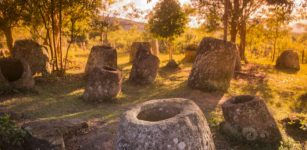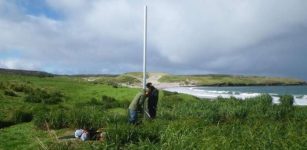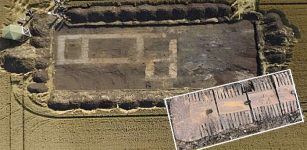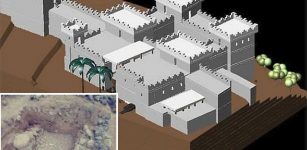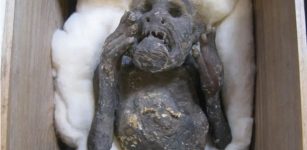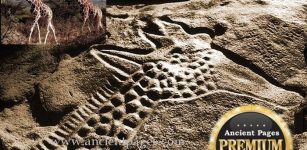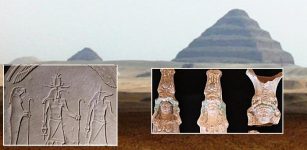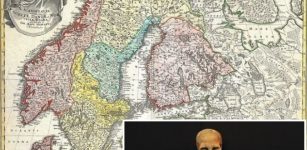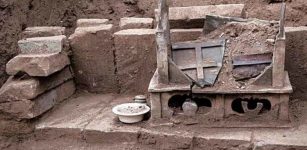Graves Of Celtic Princes Reveal How Powerful Women Were In Pre-Roman Germany
Conny Waters - AncientPages.com - The ancient Celtic civilization of the pre-Roman Iron Age in Western and Central Europe left a rich cultural heritage, evident in massive burial mounds and remarkable archaeological artifacts. Despite this wealth of evidence, much about this society remains shrouded in mystery.
The massive burial mound at Hochdorf-Eberdingen in southwestern Germany contained the remains of an individual believed to have been a tall king or ruler. Credit: O. Braasch/Landesamt für Denkmalepfelege in Regierungspräsidium Stuttgart
Recent scientific investigations have shed light on the graves of two Celtic princes, among the tallest individuals in their society. These men, who lived around 510 B.C.E., stood nearly 2 meters tall and were buried 10 kilometers apart in elaborate graves, surrounded by gilded drinking horns, luxurious cloth, and ornaments made of gold, amber, and ivory. They were prominent figures in the early Celtic culture, which flourished north of the Alps between 700 and 400 B.C.E. However, the most remarkable discovery is not their stature or grave goods.
In a groundbreaking collaboration between the State Office for the Preservation of Historical Monuments in Baden-Württemberg and the Max Planck Institute for Evolutionary Anthropology (MPI-EVA) in Leipzig, Germany, researchers have successfully reconstructed the genomes of Celtic individuals from several burial mounds for the first time.
Visualization of the central grave/main burial of the Hochdorf mound. Credit: Landesmuseum Württemberg, FaberCourtial; Thomas Hoppe (scientific reconstruction)
Genetic analysis of their skeletal remains and more than two dozen other sets of remains from the region suggests that this culture practiced a matrilineal power succession system. In contrast to most societies, the status of these early Celts, including the two tall princes, was determined by the status of their mothers, as reported in a recent study published in the journal Nature Human Behaviour.
The Hallstatt culture, represented by the burial mounds of two men on the outskirts of Stuttgart, Germany, and hundreds of others, offers insights into a society at its zenith. This culture, which may have benefited from the newly developed iron technology for tools and weapons, exhibited remarkable wealth and connections. They imported amber from the Baltic, tin from the British Isles, and gold and ivory from the Mediterranean. Their walled settlements rivaled contemporary cities in Italy and Greece in size and sophistication.
Credit: Landesmuseum Württemberg, FaberCourtial; Thomas Hoppe (scientific reconstruction)
The burial mounds of their elite were massive, up to 100 meters across and more than 6 meters tall, prominent features in the landscape around their settlements. However, the process by which these early Celts selected their leaders remained a mystery. Researchers debated whether the individuals buried under these mighty mounds inherited power, earned it through leadership during their lifetime, or were recognized as religious figures.
New archaeological discoveries from two affluent burial sites, Eberdingen-Hochdorf and Asperg-Grafenbuhl, have shed light on the social dynamics of ancient Celtic societies. Each site featured a central grave surrounded by over a dozen smaller ones. The central burials contained the remains of men with robust bones, indicating a large and muscular physique, accompanied by numerous high-quality grave goods.
Bronze cauldron with lion decorations with a capacity of about 500 liters Hochdorf. Credit: Landesmuseum Württemberg, P. Frankenstein/H. Zwietasch
Through the analysis of nuclear DNA, researchers have uncovered that the men buried in the central graves were second-degree maternal relatives. This finding suggests they could have been grandfather and grandson, uncle and nephew, or even first cousins.
"It has long been suspected that the two princes from the burial mounds in Eberdingen-Hochdorf and Asperg 'Grafenbühl' were related," says Dirk Krausse of the State Office for the Preservation of Historical Monuments, "but only now has this assumption been confirmed by the new analyses."
However, as study co-author Stephan Schiffels, a geneticist at the Max Planck Institute for Evolutionary Anthropologypointed out “Genetics alone doesn’t tell us.”
The investigation into the ancient riddle took an intriguing turn when scientists focused on the wooden remains and elaborately constructed grave chambers of the skeletal remains. Previous archaeological studies had precisely dated the burials by analyzing the tree rings in the wood, while examinations of the bones revealed the ages at which the individuals had died.
This contextual information proved invaluable for the research team, as it showed that the two men were born approximately 50 years apart. Furthermore, chemical traces in the bones suggested that both individuals had grown up in the same region.
Gold jewelry of the Lady of Ditzingen-Schöckingen. Credit: Landesmuseum Württemberg, H. Zwietasch
Based on their findings, the researchers concluded that the most plausible explanation was that the Eberdingen-Hochdorf man's sister was likely the mother of the man buried in Asperg-Grafenbuhl – a kinship arrangement known as matrilineal avuncularity.
This hypothesis was further strengthened by discovering another grave mound in the region. In this mound, a woman was interred in the central grave, accompanied by a young man with similar mitochondrial DNA markers, indicating a connection through the maternal line.
"Based on the fairly precise death dates, estimates of age at death and the genetic similarity of the two princes, only one scenario comes into question as uncle and nephew, more precisely: the sister of the Hochdorf prince was the mother of the Asperg prince," explains Stephan Schiffels from MPI-EVA.
"This result shows that political power in this society was most likely inherited through biological succession, comparable to a dynasty," says Joscha Gretzinger from MPI-EVA.
Scientists say this study has resulted in an intriguing observation about the elite members of the Hallstatt society. The evidence suggests that their connections extended beyond mere biological kinship. The wealthy central graves were surrounded by individuals who were not directly related, including women buried with children who were not biologically theirs. This finding indicates that the elites of that era may have practiced fostering, where children were sent to live with neighboring families, potentially strengthening social ties and alliances among the elite class.
The research team says the Celts' genetic connections extended beyond the region of Baden-Württemberg. A comprehensive analysis of their genetic origins reveals that they were most likely derived from present-day France. In this region, their ancestry was widespread throughout southern Germany during that era.
See also: More Archaeology News
Several individuals exhibited genetic origins from Italy, aligning with the Mediterranean-style objects discovered in their graves.
The study provides a crucial piece of the puzzle in understanding European history during the Middle and Late Iron Age, which lacks extensive written records compared to the Roman and other Early Medieval eras. By examining genetic evidence, researchers can unravel the intricate connections and migrations that shaped the diverse populations of ancient Europe.
The study was published in the journal Nature Human Behaviour
Written by Conny Waters - AncientPages.com Staff Writer






